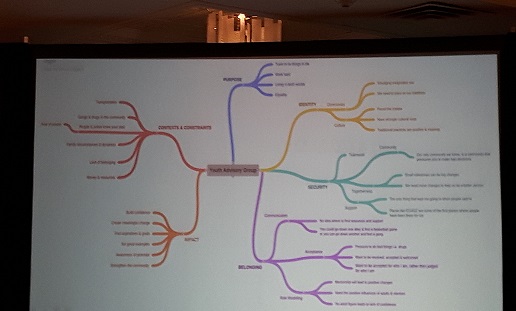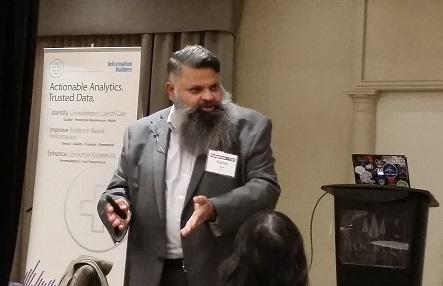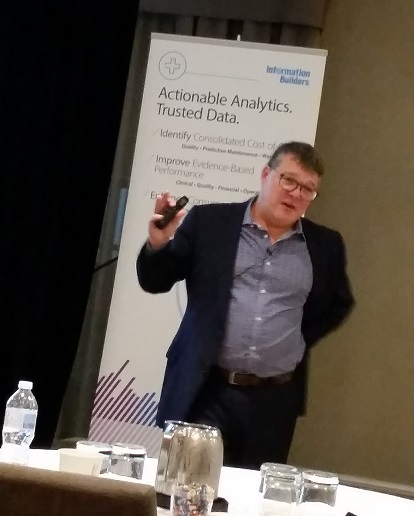Another country was heard from at this year’s Information Builders Symposium. Held in the rolling foothills of Ontario’s Hockley Valley, Advanced Analytics in the Public Ecosystem offered keen insights drawn from the voice of industry, with consulting, security and BI platform experts providing seasoned views on the importance and practice of analytics in the public sector. Over the past several years, Symposium events have focused on reporting from practitioners – and peer sharing on healthcare deployments in particular: 2018 featured compelling analytics use cases from the City of Saskatoon and York Regional Police, while reinforcing a programmatic shift towards broader vertical representation and more wide-ranging discussion of technology challenges and opportunities.
Symposium launched with a presentation on a new report outlining expectations for the new Ontario government’s spending priorities, a topic designed to attract the attention of an audience composed for the most part of municipal, provincial government and other agency workers. Commissioned by the Ontario Treasury Board Secretariat, the Ernst and Young report, Managing Transformation. A Modernization Action Plan for Ontario, is a review of provincial expenditures for fifteen years ending fiscal 2017/18, which included in its mandate an analysis of spending, jurisdictional benchmarking, and the identification of programs and operations that would be good candidates for effectiveness and efficiency improvements. Based on his interpretation of the E&Y analysis, consultant Steve Lough pointed to key report takeaways – his view as the harbinger of go forward activities on the part of government. According to Lough, the new PC regime’s fiscal target is a four percent reduction in the province’s deficit, and to help government achieve this goal, Ernst and Young has prescribed a better framework for public expenditure management featuring: a commitment to evidence-based decision making, a modern relationship with labour, a citizen centered and digital first mindset, modern risk-based regulatory management, renewed funding models that incent productivity and performance, a strong focus on intergovernmental coordination and a clear understanding of the role of government as a steward of investments. For Lough, government workers and Symposium attendees, the salient point is government need for better data on public expenditures, as input to digital modernization and efficiency improvements in service delivery sectors in particular (healthcare, education, etc. as opposed to the bureaucracy), which, according to E&Y were responsible for 99 percent of spending increases over the period under review.

In one shape or another, Symposium returned to this key theme over the course of the event – the need for better data management, and a robust data and analytics framework to support government decision-making, with the goal of improving the effectiveness of service delivery, departmental performance, information sharing and accountability. In a workshop session, attendees were invited to speculate on the impact of a ‘digital first’ approach within their respective organizations, and in a rare appearance at Symposium, Information Builders CMO Michael Corcoran spoke to key issues in data management, such as establishing trust in data through quality initiatives, the importance of integrating large volumes of siloed data to develop new insights, and the need to collaborate on these findings to transform information to action. Citing multiple examples from the IB private sector client list, Corcoran pointed to opportunities for time and cost savings that can be achieved through use of the IB platform, noting that this potential could easily be translated to predictive modeling built on public databases. He also argued the importance of scale, which can be achieved through the embed of analytics in applications deployed across the user base, as a means of addressing real operational challenges. New sources of business value are uncovered, Corcoran explained, by extending analytics beyond the analyst group and operationalizing data insights throughout the organization to drive real digital transformation. “BI is no longer a data science technology; its now a collaborative technology,” he observed. A key piece of collaboration is data presentation – delivered traditionally through dashboards and reports – but increasingly through visual media as well. As Vicky Lozovsky, services director, IB market support, noted in her presentation on IB’s new infographics functionality, the aim of effective communication of data that extends from the data scientist to management, front line workers, partners and customers is “information that is easy to understand, eye catching, and connects with the audience.”
In his presentation on youth incarceration, Jazz Pabla, technology infrastructure manager for the City of Saskatoon, provided a compelling example of the benefits of broad distribution of information by a government agency. As a contestant in the federal government’s recent Smart Cities Challenge, Saskatoon chose to focus on a human centric demonstration of smart city. According to Pabla, in addition to technology solutions, “smart cities also means smart people and smart processes,” in which “smart decisions, and smart coordination” are built on information sharing. Saskatoon’s smart contest entry was essentially a data integration and sharing initiative designed to address the high rates of incarceration for Indigenous youth, who represent 80 percent of those who are incarcerated in the city. Pabla described Saskatoon’s demonstration project as a “human mind map based on information provided by the community” focused on delivering information resources online to help youth make better decisions. While Saskatoon already had indigenous youth programming, Pabla explained that the city lacked a data platform for sharing information from across the range of support institutions. In building its platform, Saskatoon explored new methods for defining need and existing resources; the team conducted workshops with youth and consulted with elders in native communities, adding their input to data on existing NGO and community services, transportation, and other services, creating a technology solution that would serve the unique needs of youth, many of whom struggle with finding access to the most basic human resources.

Karim Virjee, VP of data strategy, vLiberty, expanded on this notion of technology-based potential for service improvement through his analysis of the timeliness and impact of targeted analytics. Like money, physical things, cities, business processes, supply chains, food services, hospitals, human resources/talent, Virjee argued that data is essentially an asset that allows individuals and institutions to get where they need to go – to sharing information with indigenous youth, for example. In government, he observed, data-guided decision making often falls apart because decisions are made for other reasons. But armed with a clear sense of purpose – “what is your [data] why,” he asked the audience – analytics will support the discovery, interpretation and communication of observed patterns, helping users to understand what happened, what factors were involved, what will happen (forecasting, or ‘The Merlin Factor’), and what can be done about it (optimization of existing infrastructure,

processes, etc.). Interestingly, while maintaining the importance of a targeted business case, Virjee argued against a linear approach to analytics, basing his position on the availability of massive tech power provided by modern computing. Direct technology advances, including cloud computing, cloud native application architectures, containerization and API driven systems, algorithm progress beyond statistics and least-squares methods to machine learning and AI, and Big Data solutions, such as object databases, parallel data systems, stream processing and reprocessing, he explained, have combined with indirect advances in sensors, communications and conductivity, including 5G and edge computing, to enable scale that is driving a new analytics paradigm. According to Virjee, with modern compute capabilities, response to one analytics query frequently leads to a new question, creating a cycle of inquiry – and ultimately, “emergent change.” “Change cannot be orchestrated; change is not linear; and change is not sequential,” he explained, and hence the goal for change agents should be to build flexible systems, environments that are responsive and can adapt to data outcomes. Practically speaking, this involves road mapping via a wholistic strategy that outlines the intent of analytics investigation, a digital asset management strategy that provides a framework for collecting, storing, organizing, distributing, using, protecting and sharing digital assets, and the nurture of a data-aware culture within the organization.
Recent initiatives from the York Regional Police (YRP) provide evidence of this potential for ‘emergent change.’ Some years back, YRP embarked on an ambitious business intelligence journey, and now have the strategy, data warehouse, data quality and integrations in place needed to apply analytics to problems across the organization. In a talk entitled, Intelligent Technology for Modern Policing, Greg Stanisci, YRP asst. manager Strategic Services Bureau, BI and Data Analytics outlined several key BI initiatives designed to help the force optimize its use of resources, while improving service delivery. For example, the BI team has built a Live Unit Status dashboard, used in the YRP NOC that relies on analysis of data fed from the Computer Assisted Dispatch system to locate cars in real time, which also taps into officer skills, language and experience assessments in order to dispatch the right resource to the crime incident in a matter of seconds, as opposed to the hours it took with legacy systems. To further support the maintenance of public safety and security, YRP have also built a Real Time Crime Analysis/Investigation dashboard that provides current and trend analysis on crime in a district, which can list individuals in that area who have been charged in the past, rating the severity of their charge(s), and which provides descriptions of the crime incidents, enabling keyword searches on unstructured text. Built using Information Builders’ Magnify search tool, and backend integration of data from the YRP’s Records Management System and unstructured text reports/files, this dashboard also features network link diagrams that establish links between vehicles, persons of interest, gang members, addresses, drugs or weapons, etc. to speed crime investigations. An Officer Activity dashboard provides performance metrics for frontline officers – how many tickets, how many arrests, etc., have been made – with built in BI that can benchmark an individual against his/her team or against the leader in that activity. With data to support performance assessment, supervisors can recognize (reward) high performers, or help motivate low performers. The dashboard also contains heat maps that predict where crimes are likely to occur, establishing priority zones in which officers can measure their own performance. According to Stanisci, this kind of performance insight is a key driver of cultural change within the organization – as, ultimately, will be dashboards that track officer activities to establish the economics, or true cost of policing.
A good indicator of YRP’s transition to an analytics-based culture is the use of business intelligence by staff outside the BI group. For example, Dr. Kyle Handley, CPsyc and lead psychologist at YRP, who is self-proclaimed “not a data scientist” but rather a clinician who is also responsible for mental health strategy for the police force, has also looked to the integration of mental heath and emerging technologies to solve issues with service access. According to Handley, while YRP maintains many different services for internal members, officers are reluctant to come forward because of the stigma attached to mental health challenges, and there was no consistency in the way individuals access services, which ideally would provide information to the force that could serve as a reference point for service improvement going forward. To better manage these issues, Handley looked to reduce barriers to service access by establishing greater ease of use; if individuals knew what services were available, and which were right for them, they would no longer wait for a crisis before seeking help. And to address problems with the lack of integration between mental health services that operate independently rather than in a coordinated fashion to deal with the spectrum of challenges on a mental health continuum, YRP moved to a stepped care approach that begins with screening/consultation and moves through hospitalization. To modernize step one, Handley deployed IB’s WebFOCUS technology to create opportunity for innovation in mental health evaluation and service delivery. Specifically, he set up a BI system that could measure “officer stress” through various mental health indicators, such as days off work due to stress over specified periods, or the frequency of officer response to stress calls (baby deaths, for example, are ranked highest in terms of stress), linking these with various “steps” using the networking linkages noted above. Provided by IB partner, Cambridge Intelligence, these linkages, which technical sales manager Christian Miles described as “graph analytics,” deliver a visual representation of node to node connections, to establish stronger and weaker correlation between different factors. For Handley, the goal in using the Cambridge Intelligence KeyLines product was to identify stress points in real time and to develop an individualized view of stress, rather than assume that a particular unit is most at risk. With KeyLines embedded within an IB dashboard, Hanley can establish thresholds for individuals, identifying the point at which various mental health services might want to do a preventative intervention. Though digitization, the mental health unit can now monitor what the officer is doing, and proactively reach out, as opposed to waiting for the stressed officer to self-identify.
Information Builders’ two-day Symposium delivered multiple, additional examples of end user innovation with its business intelligence platform. Gustavo Espinosa, Brampton BI, integration and MDM program manager and Mike Mulik, by-law enforcement project supervisor for the city spoke on “Dashtopia,” the city’s use of various IB tools to create its cloud-based “Omni Information Hub” with analytics dashboards for the PMO (project management office), Transit, Enforcement, Recreation, Fire (in test mode), Service Brampton (call centre) and Citizens, which all told monitors 113 KPIs. Markham Stouffville Hospital provided additional commentary on KPIs, with Grace Auh, MSH manager of BI and analytics, asking “are you connecting dots or collecting dots?” Auh and MSH director of financial planning and business analytics Tim Jenkins stressed the importance of structure and process: set specific objectives by area, build a strong plan with timelines and milestones, and focus on the foundation (rather than a set of reports) and “the sky’s the limit” for the potential uses of data within the organization.Winners of this year’s Conestogo College Health Information Challenge, students Vivian Trinh, Roselyn Bevis, Ritam Panchal and Jaimie Short presented An Actionable Approach: A Public Health Dashboard, showcasing college program work that has been supported through IB’s unique relationship with Conestoga.

Other providers were also present, including Collibra, a more recent IB partner that offers an advanced governance solution based on the extensive use of metadata, which is used to define data, identify its location, offer information on data stewardship, and do cataloguing to speed access and improve trust in data. Another vendor, and new IB client, cybersecurity-as-a-service firm eSentire, also made an appearance to speak to risks associated with data usage. In his talk, Cyber Threats and Security in the Public Ecosystem, eSentire president and COO J Paul Haynes described the changing threat landscape (driven by social engineering, ‘spoofing the boss’ tactics, targeted attacks, phishing campaigns, ransomware, cryptojacking, systematic vulnerability exploitation and watering holes), focusing on vulnerabilities in the healthcare sector, which Haynes stated have experienced a 55 percent increase in cyber threat activity over the past year. With the means (there is easy access to cyber weaponry, minimal cyber skills are required as skills are open source and can be consumed in SaaS models), motivation (cybercrime is very lucrative) and opportunity (there are very few negative repercussions as online international crime is difficult to track or prosecute), criminals act with impunity, swelling attack incidence numbers. In this situation, Haynes argued that traditional methods of defence offer little protection: conventional thinking on threat intelligence that relies on known attacks, known signatures, known threats is not really useful as the “bad guys” also have this information and can change their methods, and while SIEM is helpful, it does not provide detection or containment services, but instead can generate “false fatigue” as up to 1000 false positives (security events) can be logged in a single day.

As an effective alternative, Haynes advised use of an “adaptive security architecture and MDR (managed detection and response services) that can address the unique needs of an organization by developing protection that is specific to the client’s particular situation. eSentire’s approach, for example, is based on behavioural analytics that will detect anomalies (in user or network behaviours) and amplify these, allowing the user to more quickly escalate to remediation activities. At a time when security and privacy regulation is intensifying in terms of requirements (a revised PIPEDA comes into effect November 1, 2018, which defines the ‘significant harm’ of a data breach much more broadly, and increases fines for privacy offences), Haynes also recommended incident response planning, covering the role of law enforcement, legal, investor and stakeholder relations, compliance, regulators, the board or Commissions and PR, as well as regular simulations of breach response. With event management planning, he explained, and by working through the “dirty dozen” attack methods for deriving illegal access to data assets, organizations can develop process to respond to all kinds of threats.
If atypical, Information Builders’ introduction of partner and vendor voices to this year’s Symposium was a welcome departure. Having daily experience in technology deployments and current with the latest innovations in BI and analytics, providers were able to share knowledge on critical topics including data security, governance, data networks and the operationalization of data insights throughout the organization. But a special place was reserved, thankfully, for building analytics understanding through the use case – in government IT and service agencies, in hospitals, colleges and police services – which are best fit for demonstrating the art-of-the possible.








